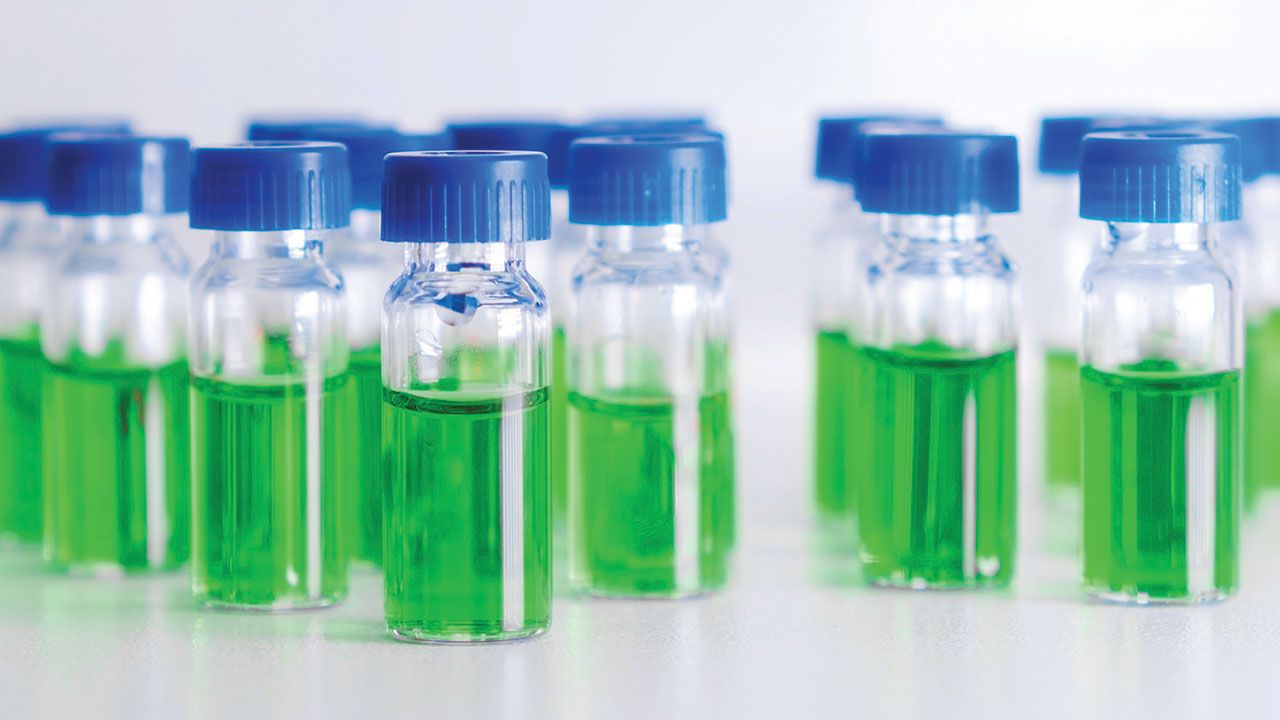Determining Low PPB Levels of Nitrite in Polymeric Excipients
In this paper, the authors introduce a method that combines ion exchange chromatography with an easier-to-perform, simpler one-step post-column derivatization that is selective to nitrite and visible spectrophotometric detection to allow high sample loading volumes without affecting resolution.
HPLC vials with green sample of plant extracts. Developing of drugs based on natural products. Biochemical analysis | Image Credit: ©vladim_ka - stock.adobe.com

Peer-Reviewed
Submitted: May 1, 2024
Accepted: June 28, 2024
Abstract
In this paper, the authors introduce a method that combines ion exchange chromatography with a easier-to-perform, simpler one-step post-column derivatization that is selective to nitrite and visible spectrophotometric detection to allow high sample loading volumes without affecting resolution. The method introduced here can be broadly applied to multiple polymeric excipient types. Ion-exchange chromatography post-column derivatization is used to determine ultra-low levels of nitrite in three excipients.
The 2018 discovery of the probable and possible human carcinogen N-nitrosodimethylamine (NDMA), in the generic API valsartan, used to treat high blood pressure, began a chain of recalls and a global investigation into the reaction mechanisms that can lead to nitrosamine formation. Over the next year, FDA extended its survey of active pharmaceuticals, and the presence of certain N-nitrosamines were also reported in products containing pioglitazone, ranitidine, and metformin (1,2). Regulatory requirements for mitigation strategies and risk assessments were quickly set in place. A number of years after these discoveries, a significant amount of research has been published detailing the formation and detection of nitrosamines in drug products. While there are numerous hypotheses of how nitrosation occurs, the most common mechanisms indicate that nitrosation occurs under acidic conditions, where nitrite reduces to the nitrosonium ion. This ion then reacts with any secondary amines remaining in the API from the manufacturing process and results in nitrosamine drug substance-related impurities (NDSRIs), including simple nitrosamines such as NDMA and N-Nitrosodiethylamine (NDEA) (3–6).
In 2021, FDA published the first, finalized guidance on nitrosamines, Control of Nitrosamine Impurities in Human Drugs (7).In 2023, FDA published a final guidance document for drug manufacturers outlining the recommended acceptable intake limits for NDSRIs (8). NDSRIs can be formed when secondary amine/amide in the drug product reacts with traces of nitrites in the reagents (relevant to APIs synthesis), water, packaging components, and, last but not the least, in excipients. Pharmaceutical companies are now invested in the screening for the presence of nitrite in their active and inactive ingredients,and, in response, suppliers of drug active and inactive ingredients have set out to reduce and restrict nitrite levels in their products (9). In the context of the excipient industry, with this effort comes the challenge of detecting and quantifying nitrite at lower than parts per million (ppm) levels in a broad range of synthetic and nature-derived polymeric excipients. This communication introduces an analytical method for trace level detection of nitrite (< 30 parts per billion [ppb]) in a broad range of polymeric excipients commonly used in drug formulations. Specifically, povidone, a tablet binder, crospovidone, a superdisintegrant, and hydroxypropylmethylcellulose (HPMC), a controlled release polymer, were chosen to describe the versatility of the method procedure.
Typical methods for nitrite quantitation in drug actives and drug products are based on ion exchange chromatography (IC) coupled with ultraviolet (UV), electrochemical (EC), conductivity (CD), and, less frequently, mass spectrometric (MS) detection (10–12). Both UV and conductivity detection are often used for the analysis of drinking water, providing excellent sensitivity for many ionic impurities such as metal ions, chloride, and nitrite. Direct detection of solute ions by UV, however, is limited in sensitivity compared to conductivity detection for inorganic ions due to the lack of a selective chromophore. Conversely, IC–CD is at a disadvantage when it comes to quantifying nitrite in solutions containing high levels of chloride (e.g., metformin hydrochloride), which strongly interferes with nitrite detection (13,14).
Regarding polymeric excipients, detection of nitrite at low levels is further complicated by identifying an appropriate sample preparation technique. Linear polymers such as povidone, specifically low molecular weight grades, easily dissolve into water and have a limited effect on the ion exchange column or UV detector. For conductivity detection, however, the high concentration of dissolved polymer can lead to contamination of the suppressor and the conductivity cell.
For insoluble or swellable polymers, direct injection is not possible, and extraction methods must be employed. Extraction, in general, creates the need for a higher dilution in sample preparation, negatively impacting the quantitation limit of nitrite in the polymer. A way of counteracting this is to increase injection volumes, but then, interference or coelution of matrix ions with nitrite is more likely.
Mass spectrometric detection can provide higher sensitivity and selectivity but can be more complex in terms of operation and interpretation. An article was published on low level nitrite detection in microcrystalline cellulose (MCC), another common excipient (15). While a notable limit of detection was achieved (5 ppb) for this polymer, it required the use of selected ion monitoring, isotope labeling, and an after-column switching valve for flushing salts off the ion source. The use of an IC–MS method such as this would be impractical for routine screening of a wide range of polymeric excipients.
In this paper, a method is introduced that combines IC with an easier-to-perform, simpler one-step post-column, nitrite selective and visible spectrophotometric detection to allow high sample loading volumes without affecting resolution. The derivatization step is based on the well-known diazotization reaction of nitrite with the mixed reagent system referred to as Griess reagent (0.05% napthylethylendiamine dihydrochloride plus 0.5% sulphanilamide in 5% phosphoric acid) (16). Griess reagent is commonly sold in assay kits for spectrophotometric determination of nitrites in drinking water (limit of 1 ppm). It has also been utilized for the analysis of nitrite/nitrate in dairy products (17) and biological fluids (plasma, urine, and cell culture supernatant) (18) via a two-step process where nitrate anions are first reduced to nitrite by cadmium catalyst and subsequent diazotization reaction. Here, it is used to remove matrix ion interferences through detection of the azo dye at its peak absorption wavelength, 540 nm.
Coupled chromatographic and single-step nitrite derivatization via Griess reagent technique, both pre- and post-column for nitrite analysis have significant advantages over other traditional nitrite detection/quantification methods, such as method specificity, sensitivity, applicability and practicality. Moreover, the method introduced here can be broadly applied to multiple polymeric excipient types. Described here is the successful utilization of IC post-column derivatization to determine ultra-low levels of nitrite in three excipients: povidone (plasdone K-29/32, Ashland), crospovidone (polyplasone XL, XL-10, Ashland), and hydroxypropylmethylcellulose (HPMC) (benecel K100M XR, Ashland).
Click here to read the articleAbout the authors
Helen K. Gerardi is principal scientist; Lawrence Feeley is scientist; Paul Suszczynski is senior staff scientist; Zachary Digby, is staff scientist; and Fan Wu is technical director; all with Ashland.
Article details
Pharmaceutical Technology®
Volume 48, Number 9
September 2024
Pages: 24–30
Citation
When referring to this article, please cite it as Gerardi, H.K.; Feeley, L.; Suszczynski, P.; Digby, Z.; and Wu, F. Determining Low PPB Levels of Nitrite in Polymeric Excipients. Pharmaceutical Technology 2024 48 (9).
